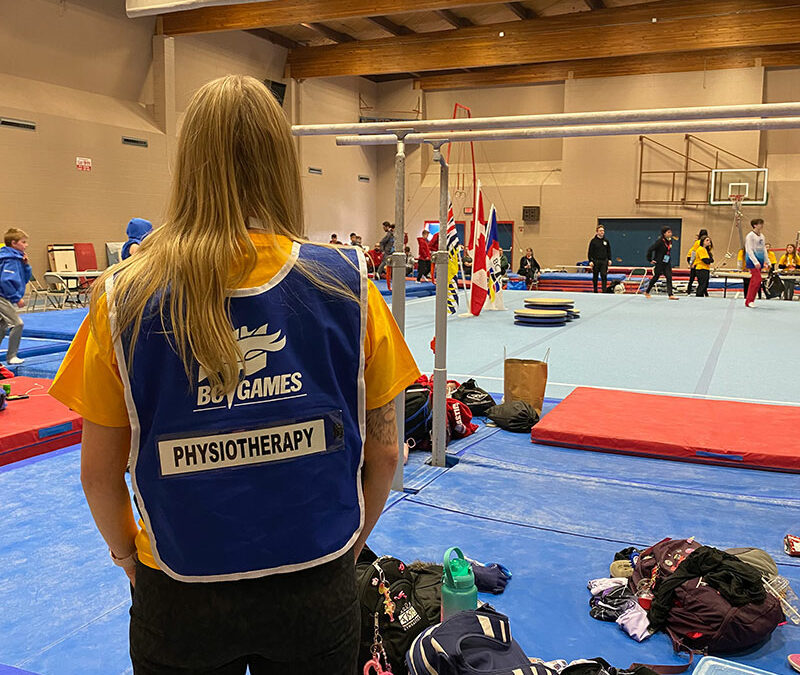
Gymnastics
Gymnastics
Gymnastics is a sport that requires strength, flexibility, balance, coordination, and endurance. While its aerial and acrobatic movements can shock and awe, these movements can increase an athlete’s risk for injury.
What are the common injuries in gymnastics?
For paediatric populations, the most common gymnastics injuries include: sprains, strains, fractures, and dislocations. It has been reported that roughly 97% of gymnastics injuries end up in emergency departments. The most common sites of injuries are the ankle, lower leg, shoulder, Achilles, trunk, and foot.
One of the most prevalent chronic issue experienced by gymnasts is low back pain. Low back pain has been reported in up to 85% of gymnast populations. The most common low back injury is spondyolysis.
What are the risks?
Risk factors for injury in gymnastics include: a previous history of injury, competing before complete recovery, improper technique, overtraining/overuse, and environmental factors such as landing surfaces.
How can I prevent injury?
To begin, it should be noted that 80- 97% of injuries happen in practice compared to competition.
Some of the best ways to prevent injury are to:
- Avoid over training.
- Learn proper form and technique for skills in order to protect the body from repeated motions.
- Engage in a proper warm up.
- Engage in specialized strength and conditioning programs that have been developed for gymnasts.
- Manage pain and physical issues early, before they become chronic.
Why is physiotherapy important?
Nearly 90% of elite gymnasts report sustaining one or more injuries that result in reduced training capacity. These athletes spend roughly 14% of their time training at sub-optimal levels. Physiotherapists can help to prevent and manage these injuries, which in turn increases optimal training time.
Physiotherapists with training in gymnast populations can help to identify risk factors, diagnose and treat acute and chronic injuries, educate on proper warm up techniques, provide relevant strength and conditioning programs, and screen for proper form in the performance of gymnastics skills to prevent biomechanical errors.
Credentials
Lindsay Wourms, PT, MScPT, Special Focus in Paediatrics
Former competitive gymnast
Gymnastics coaching experience with both recreational and pre-competitive groups
Special education in gymnastics rehabilitation and injury prevention
Physical Therapist on site for gymnastics at the BC Winter Games 2023
References:
References Hecht, S. S., & Burton, M. S. (2009). Medical coverage of gymnastics competitions. Current Sports Medicine Reports, 8(3), 113–118.
Heinen, T., Pizzera, A., & Cottyn, J. (2010). When is manual guidance effective for the acquisition of complex skills in Gymnastics? International Journal of Sport Psychology, 41(3), 255–276.
Kerr, Z. Y., Hayden, R., Barr, M., Klossner, D. A., & Dompier, T. P. (2015). Epidemiology of National Collegiate Athletic Association women’s gymnastics injuries, 2009–2010 through 2013– 2014. Journal of Athletic Training, 50(8), 870–878.
Kirialanis, P., Dallas, G., Di Cagno, A., & Fiorilli, G. (2015). Knee injuries at landing and take-off phase in gymnastics. Science of Gymnastics Journal, 7(1), 17–25.
Kirialanis, P., Malliou, P., Beneka, A., Gourgoulis, V., Giofstidou, A., & Godolias, G. (2002). Injuries in artistic gymnastic elite adolescent male and female athletes. Journal of Back and Musculoskeletal Rehabilitation, 16(4), 145–151.
Kolt, G. S., & Kirkby, R. J. (1995). Epidemiology of injury in Australian female gymnasts. Research in Sports Medicine: An International Journal, 6(3), 223–231.
Kox, L. S., Kuijer, P. P. F. M., Kerkhoffs, G. M. M. J., Maas, M., & Frings-Dresen, M. H. W. (2015). Prevalence, incidence and risk factors for overuse injuries of the wrist in young athletes: a systematic review. British Journal of Sports Medicine, 49(18), 1189-96.
Kruse, D., & Lemmen, B. (2009). Spine injuries in the sport of gymnastics. Current Sports Medicine Reports, 8(1), 20–28.
Nemeth, R. L., Von Baeyer, C. L., & Rocha, E. M. (2005). Young gymnasts’ understanding of sport‐ related pain: a contribution to prevention of injury. Child: Care, Health and Development, 31(5), 615–625.
Sands, W. A., McNeal, J. R., Jemni, M., & Penitente, G. (2011). Thinking sensibly about injury prevention and safety. Science of Gymnastics Journal, 3(3), 43-58. Singh, S., Smith, G. A., Fields, S. K., & McKenzie, L. B. (2008). Gymnastics-related injuries to children treated in emergency departments in the United States, 1990–2005. Pediatrics, 121(4), e954–e960

Lindsay grew up in Kamloops, BC where she competed for many years as an artistic gymnast. She got to know the physiotherapy profession very well in that time, and decided to pursue her passion for rehabilitation with a career in physiotherapy. She graduated from the University of Alberta in 2017 with a Masters of Science in Physical Therapy and worked in Edmonton before moving back home to BC.
Lindsay has experience treating clients of all ages and backgrounds, whether their injuries be from a motor vehicle accident, work-related, or athletic. She has a strong interest and experience in treating gymnasts, dancers, and baseball players. She approaches the treatment and management of all conditions with a focus on understanding client goals, developing individualized rehabilitation plans, and providing education, open communication, and hands on treatment.
